How Does a Swamp Cooler Work? The Surprising Answer
-
Pete Ortiz
- Last updated:
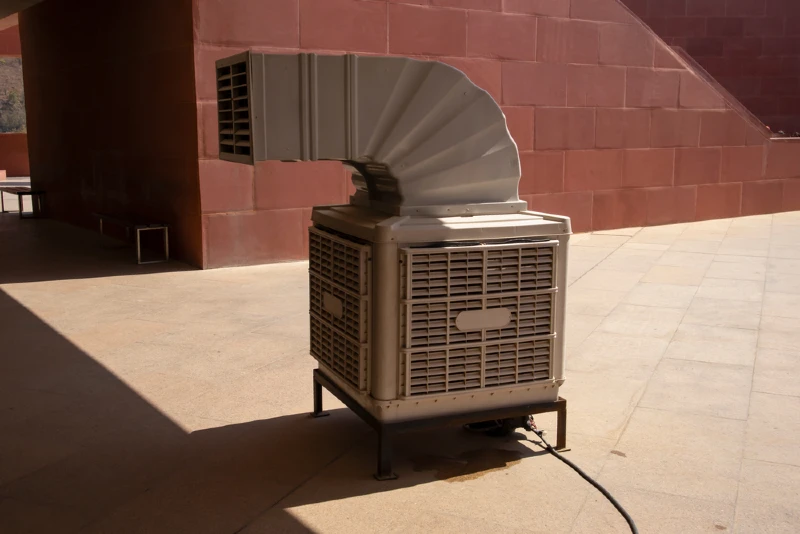
Anyone who has broken a sweat knows how evaporation can keep you cool and comfortable in intense heat. Unless you’re one of the rare 2% of people using a swamp cooler, you may not know that we can use those same principles on a grander scale to cool our homes.
A swamp cooler is a clever indoor air regulator and an enormous energy-saver compared to a traditional A/C. A swamp cooler simply uses the power of evaporation to cool a home’s interior. In an age of climate concerns, many can benefit from its low-cost and eco-friendly technology. Still, those benefits don’t come without accompanying drawbacks and limitations.
It takes a unique setup to make a swamp cooler effective. We’ll explain why with this breakdown of how a swamp cooler works.
Topics discussed in the article:
- How Does a Swamp Cooler Work?
- What Are the Different Types of Swamp Coolers?
- Where Is It Used?
- Advantages of Swamp Coolers
- Disadvantages of Swamp Coolers
How Does a Swamp Cooler Work?
A swamp cooler is the slang term for an evaporative cooler, an alternative to an air conditioner. It works by using the cooling power of evaporation to lower the home’s indoor temperature.
Unlike an air conditioner, which circulates indoor air, cools it, and releases heat energy outside, swamp coolers draw in dry outdoor air. The hot air passes through a cooling mechanism and then enters the home. Since it doesn’t subtract heat inside the house like an A/C return vent, you have to crack a window to release hot air outside while the cooler runs.
Evaporative Cooling Process
A swamp cooler is a metal box housing a motor, blower, water pump, water supply, and evaporative cooling pads. Besides a place to plug it in, you need a water supply line to keep the reservoir full.
- The water supply fills the swamp cooler reservoir with water.
- A pump sends the water through a series of tubes to distribute it across absorbent evaporative media pads on the cooler’s walls.
- The blower draws in hot, dry air from outside, filtering it through the wet evaporative media.
- As the hot air passes through the media, it transfers heat energy to the pads, causing the water to evaporate and the air to lose heat.
- The now cool air passes through the unit via the blower into the home
Swamp coolers typically have cooling and vent-only modes for two types of cooling. With a fan-only setting, the pump doesn’t supply the evaporative media with moisture; the unit only circulates air to provide marginal cooling.
Swamp Cooler vs. A/C
Swamp coolers don’t rely on a closed-loop refrigerant line to keep the home cool. They have no compressors nor any separate evaporation and condensing units.
The most significant difference from an A/C is the nature of the air it uses. An air conditioner is a massive dehumidifier. It draws hot, humid air from inside the house, cools and dehumidifies it at the evaporator, and then sends it back into the room.
A swamp cooler uses hot, dry air from the outside. Instead of dehumidifying, it adds moisture to the air as the evaporated water goes through the blower. With every degree the temperature drops, it boosts the relative humidity by around 1–3%.
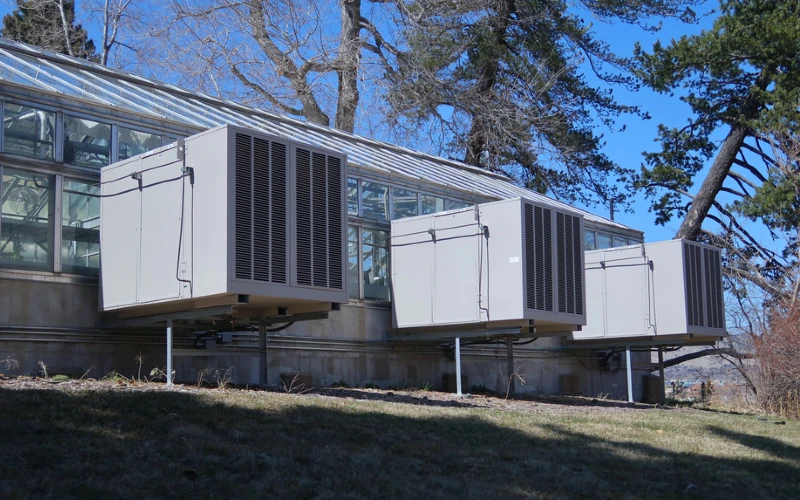
What Are the Different Types of Swamp Coolers?
Swamp coolers are about as diverse as standard air conditioners, ranging from small portable units to whole-house ducted systems. Portable coolers are stand-alone appliances that are easy to set up and provide limited cooling for numerous spaces ranging in size from 100 to 6,500 square feet. Window units are also available, providing improved cooling over similar-sized portable units and easy installation.
Newer two-stage, indirect evaporative coolers enhance the cooling capabilities by adding a heat exchanger. Hot air passes through it first before going through the direct evaporative cooler, shedding some of its heat and moisture on the way. Indirect evaporative pre-cooling improves performance for hot areas that frequently see temperatures above 100°F.
Ducted Systems
Ducted systems are available as either ground-mount or roof-mount units. Exposure to the hot sun improves the effectiveness, so many make the extra effort to put the cooler on the roof and cut holes for cool air to enter downward. These fixed units also need a water supply line to refill the media.
Portable Units
Window and mounted units generally operate more efficiently than portable units because they have constant hot air on one side and a cooled environment on the other. A portable unit on wheels draws air from the room it is cooling. Many allow you to fill the water reservoir manually or connect a hose for a constant water supply.
Portable coolers become less effective the more they cool because they begin drawing in cooler, damper air. They’re enjoyable for their convenience, directionality, and indoor/outdoor usability, but portable units usually need to sit near a hot air access point, like an open window or vent.

Homemade Swamp Cooler
You don’t need an expensive appliance to try evaporative cooling in your home. With a plastic bucket, a small fan, and some ice, you have the foundation for a small-scale swamp cooler.
- Cut several large holes (~2 inches wide) around the side of a 5-gallon bucket for cool air to vent out.
- Line the bucket with a thick, porous cloth so that it reaches the bottom of the container and covers the drilled holes in the side.
- Cut a hole in the lid of the bucket so that your portable fan can fit snugly into it (the fan will blow into the bucket).
- Add cold water and ice to the bucket.
- Turn the fan on to draw in hot air, pass it through the cold soaking cloth, and send it out the holes to cool the room.
You can play with the directionality by installing tubes to the exterior holes and varying their diameter. Like a portable cooler inside, it’s drawing indoor ambient air and will have limited effectiveness. But on a hot, dry day, it should provide noticeably improved cooling over the average box fan.
Where Is It Used?
Swamp coolers work in hot, low-humidity areas. The arid Southwest is an ideal venue, but the western United States broadly accommodates them. The eastern United States, spanning as far as Kansa,s is generally too humid for them to be more practical than a standard air conditioner.
Only 2% of Americans use evaporative coolers. But half of those people rely on them solely for cooling. Given their low cost and eco-friendliness, experts expect swamp cooler popularity to increase in suitable global locales, including India, Southeast Asia, and Australia. The global evaporative cooler market reached an $8.69 billion value in 2022. At a 6.86% compound annual growth rate, it could reach nearly $13 billion by 2028.
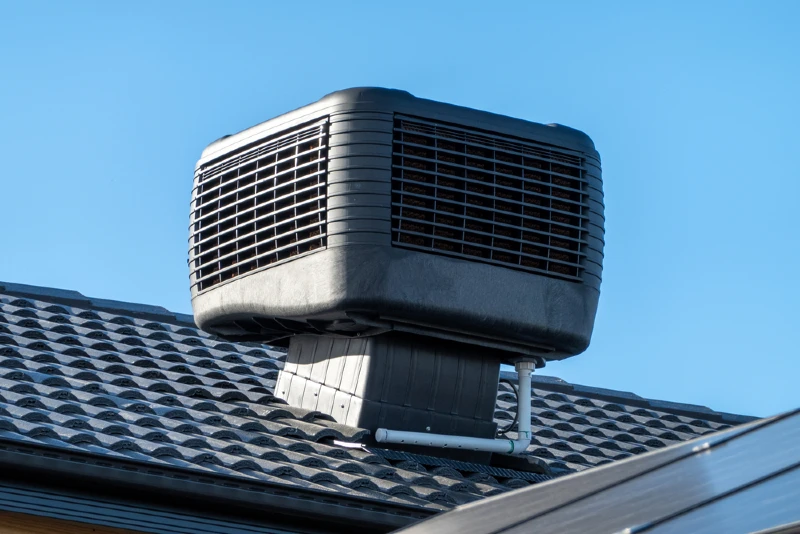
Advantages of Swamp Coolers
An evaporative cooler is significantly less expensive to set up and operate than a traditional A/C. The US Department of Energy explains that they can reduce the incoming air temperature by 15°F–40°F while only using roughly 25% of the energy. And while you can expect to pay $5,000–$7,000 for a central A/C installation, a ducted or top-of-the-line portable swamp cooler may only cost about $3,000–$4,000. Even better, savvy DIYers can construct their own with a few simple parts, cutting costs further.
Environmental Benefits
While you save money with a swamp cooler, you also help the environment through lower electricity use. Plus, swamp coolers eliminate the need for cooling refrigerant lines. Refrigerants continue to improve and become more ozone-friendly about once every decade or two, but air conditioners are still nowhere near as low-impact as a simple evaporative cooler.
An evaporative swamp cooler lets you sidestep, to a degree, the catch-22 of air conditioning. You use it to keep cool, but the incredible energy use contributes further to climate change and, subsequently, your need for more cooling. It’s an ever-worsening situation but one you can mitigate substantially by using a swamp cooler.
Comfort
If you live in a dry, hot area, you certainly don’t want an air conditioner sapping what little moisture remains in the air. The ideal comfort range is a relative humidity of roughly 30–50%, with air moist enough to keep you healthy but prevent mold growth.
Swamp coolers excel in low humidity, especially when it dips below 20%. They’ll raise the humidity to an optimal level as they cool the home, offering relief from dry skin, respiratory issues, and the risk of infections.
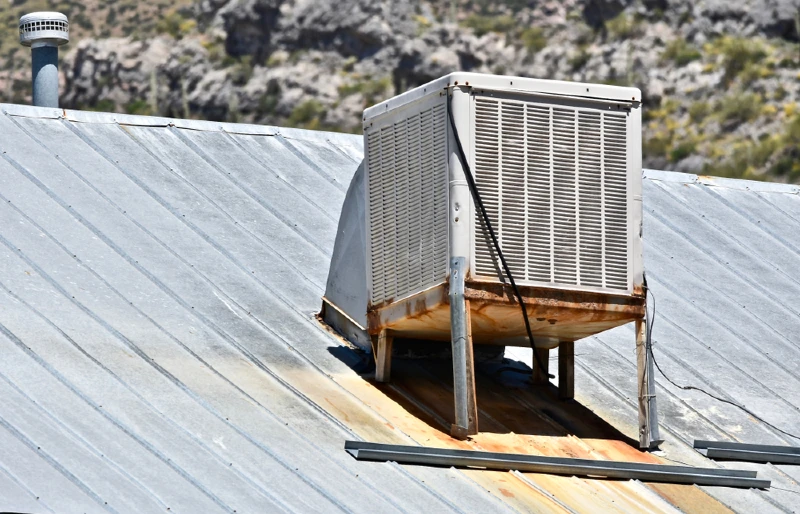
Disadvantages of Swamp Coolers
Practicality is not a strong suit for swamp coolers in most areas. When there’s no humidity in the air, they can drop the temperature by over 40°F. But once the air moisture rises to normal levels, the cooling efficiency falls off, and you start making the inside air uncomfortably stuffy. Above 50%, you set the perfect conditions for mold and mildew to set in.
Maintenance
Swamp coolers can get gross in no time due to the constant water flow through the system. The absorbent media pads, filters, pump, and reservoir require monthly maintenance. Depending on the media type and your usage habits, pad replacement or cleaning is necessary every 1–4 months to stop clogs, degradation, and contamination.
Along with the regular pad checkup, the entire unit needs at least an annual cleanse. Maintenance can be a massive hassle, especially on roof-mounted appliances where you have to worry about leaks and roof damage from constant foot traffic.
Water Use
Swamp coolers use much less energy than an A/C, often costing about $20–$25 a month. But about $5 of that cost is the water expense, one component that an air conditioner doesn’t require.
An evaporative cooler uses roughly 3–15 gallons of water daily under standard operating conditions. That’s 2–10 extra toilet flushes added to your typical water use. Unfortunately, excess water consumption like that doesn’t gel in many areas where evaporative cooling is most effective. Water rationing is a constant concern in western states, and putting your limited amount toward cooling isn’t ideal if you can opt for A/C instead.
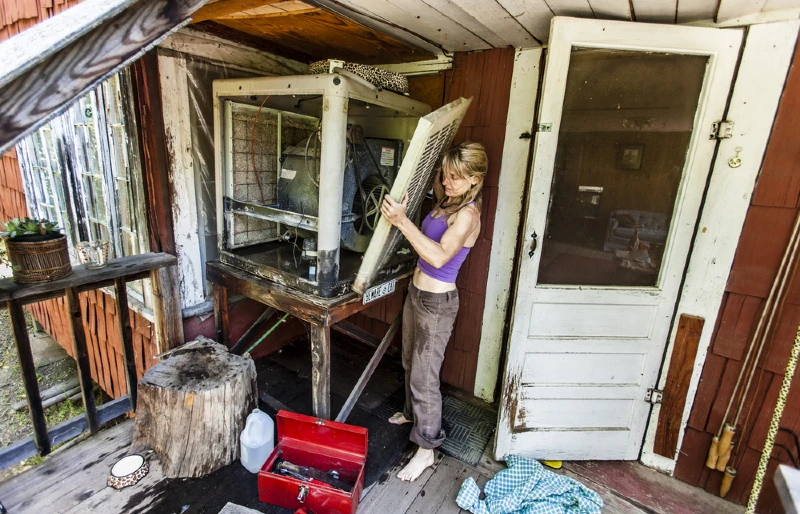
Frequently Asked Questions
How Much Does Installing an HVAC Swamp Cooler Cost?
A central swamp cooler costs roughly $1,500–$3,800 to install, including materials and labor. The size of the home is the most impactful variable, as it will affect the size and style of your unit and the time it takes to set up.
Coolers have a vast price range. Portable units for a small room often run only $50–$300. For homes over 2,000 square feet, units exceeding 10,000 CFM cost over $4,000 before labor.
Why Is It Called a Swamp Cooler?
Evaporative coolers take the nickname “swamp coolers” because of the potential to get gunky, moldy, and full of algae, similar to a swamp. The fan draws in contaminants to fill the reservoir, potentially bringing unwanted microbes and harmful pathogens into the home. Routine checks, cleanings, and component changes are essential to keep the cooler operating efficiently and safely.
Conclusion
A swamp cooler is a money-saving, eco-friendly, and potentially life-changing benefit in dry, hot regions. The initial investment is low, and the payoff is immediate. For DIYers, it lends a new opportunity, a creative and engaging project that offers practical everyday advantages. It doesn’t take much to see how evaporative cooling can help you beat the heat. And if you’re lucky, you may find it’s the key to your comfort that you never knew you were missing.
Featured Image Credit: YASH DINESHBHAI PATEL, Shutterstock
Contents



